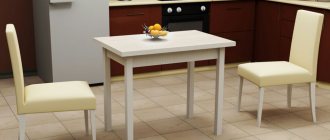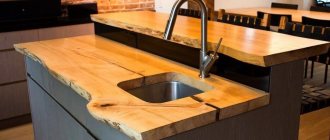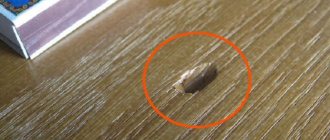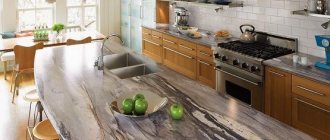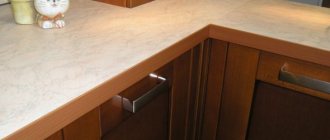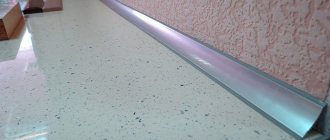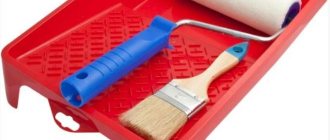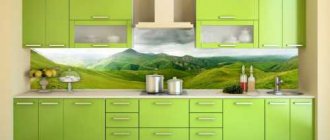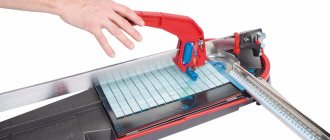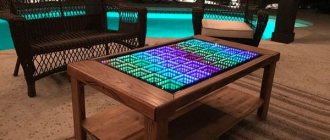The kitchen is one of the most visited rooms in the house. Its convenience and appearance are of great importance for creating a cozy atmosphere. Kitchen furniture is constantly subjected to tests: temperature changes, humidity fluctuations, frequent wet cleaning using household chemicals. Over time, there becomes a need for its repair or replacement. One of the most common operations is replacing kitchen countertops. Is it possible to perform this operation on your own? And what points must be taken into account?
Replace or restore?
The countertop is the most eye-catching element in a kitchen set. It carries a considerable functional load: food is constantly prepared on it, heated dishes are placed on the surface, liquids are spilled, and it is scratched with various objects. Because of this, over time it loses its attractiveness.
What is more profitable: restoring an old countertop or installing a new one?
Minor damage such as scratches and chips are fairly easy to repair on all types of countertops except glass. The easiest way to restore work surfaces is made of wood or laminated chipboard. But it should be remembered that in appearance a new part will almost always have an advantage over a restored one. And the new one will last much longer. In case of significant damage, there is only one option - replacement.
Replace or restore, which is better
After prolonged use, the highest quality kitchen set loses its original appearance. The countertop is exposed the most. It is possible to carry out partial restoration of the furniture in the kitchen yourself.
The first thing you should pay attention to is how damaged the kitchen furniture is. Please note the following reasons for replacement :
- replacing a countertop is much cheaper than buying a new kitchen unit;
- with a new tabletop, all the shortcomings of the previous coating and the presence of any errors made during the repair of the old model will disappear;
- a new countertop will transform the interior.
If defects appear on the surface that are not difficult to disguise, then they make do with restoration or major repairs.
Why do countertops deteriorate and why change them?
The main reasons for part damage:
- Using abrasive or aggressive detergents.
- Temperature changes upon contact with heated dishes, hob or gas stove installed nearby.
- Moisture penetrating and leaving marks on the surface.
- Pressure on the edges and corners of the slab, leading to their delamination or fracture.
- Burnout when exposed to direct sunlight.
- Mechanical wear and tear from routine kitchen operations.
- Incorrect or poor-quality installation.
A countertop that has lost its external beauty or structural integrity will have to be replaced.
What does it look like to install a countertop in a kitchen with your own hands?
If the countertop cannot be repaired or you still want to update the interior of the kitchen, then you will have to replace the countertop. You can turn to specialists for help, or you can install it yourself. Installing a countertop in the kitchen with your own hands is a simple process, but it requires certain tools and skill. If the material for the future countertop has been purchased, then you can begin installation.
Preparatory stage of work
First you need to prepare the tools:
- drills and drill according to the type of surface;
- suitable saw and jigsaw;
- sandpaper;
- sealant and spatula;
- pencil
- masking tape;
- roulette.
Tabletop Installation Tools
Next, prepare the kitchen furniture:
- all communications are turned off and disconnected;
- the sink and hob are removed;
- the old countertop is dismantled, preserving all fasteners;
- all drawers are removed.
Removing the countertop
Tabletop installation process
All types of canvases can be replaced independently, but when working with expensive materials, it is better to contact specialists.
Replacing kitchen countertops occurs in the following stages:
- the dimensions of the future surface along the edges of the headset are taken, taking into account the side margins;
- Markings are made on the canvas and carefully cut out. This action must be approached as responsibly as possible, since there will be no opportunity to redo the mistakes. Attention! It is not recommended to use an old countertop for these purposes. It may have deformations and imperfections that will affect installation;
- the necessary holes are drilled. They begin to drill the surface at the corners of the opening;
- the cut slab is installed in the prepared place. If it consists of several parts, then the joints are treated with sealant and connected. For stone countertops, a sealer is used;
Installing a countertop slab - the plate is attached using parts from the old surface or specially purchased bolts. The edge of the canvas near the wall is coated with sealant. The stone surface does not need to be secured due to its weight;
- household appliances are inserted into the openings cut out and pre-coated with sealant;
- Edge strips are attached to the sides of the tabletop. It is recommended to use metal pads near the gas stove;
- Finally, communications are connected and the surface is cleaned.
The most difficult process in all the work is the correct cutting of the canvas and holes. When purchasing material for a countertop, you can ask to prepare the surface using high-precision equipment according to pre-taken measurements. Installing the finished canvas is quite simple.
How to avoid frequent countertop replacements?
As with any other product, you can extend the service life of the product by following the operating rules:
- Carry out wet cleaning with a soft cloth, using non-aggressive, non-abrasive products - for example, dishwashing liquid.
- Place hot dishes or heating kitchen appliances on special stands.
- Immediately wipe off any moisture that gets on the work surface and reliably protect it from penetrating into the thickness of the material.
- Do not perform heavy operations on the edges and corners of the slab.
- Be sure to use a cutting board.
- Equip the legs of household appliances located on the countertop with soft pads to prevent scratching the surface when moving it.
- Protect from direct sunlight with curtains or blinds on kitchen windows.
USEFUL INFORMATION: How to remove old tiles from bathroom walls
Indications for replacing countertops
The countertop is one of the important elements in the kitchen, without which cooking would be very difficult. No matter how careful the housewife is, sooner or later she will have to face the defects that have arisen as a result of her culinary activities. Cutting food, hot dishes, chemical cleaners, all this has a negative effect on the surface. Burnt marks, stains, cut stripes, chips, etc. remain on it. If the damage is minor, you can try to restore the tabletop, but first make sure that the materials from which it is made allow this to be done. When the defects are significant and there is no desire to contemplate such “beauty” in the kitchen, then you need to think about replacing the entire countertop or a separate fragment of it. In addition to the aesthetic issue, replacing a kitchen countertop is carried out for the following reasons:
- through a damaged surface, moisture can enter the material, which leads to its swelling;
- the entry of food particles into microcracks leads to the development of pathogenic organisms;
- regular exposure of the film coating of the countertop to cleaning agents will lead to abrasion, causing the surface to become sticky and dirty;
- After renovation, the old countertop no longer harmonized with the new wallpaper or tiles in the kitchen.
Replacing the countertop in the kitchen may be necessary if there are microcracks on the surface.
Any slight deformation of the surface can lead to misalignment, drawers will no longer open, and black spots will form at the joints near the sink. The formation of mold in cracks will cause deterioration in health, especially for people prone to allergies.
Even if there is no serious damage to the kitchen surface, over time its design may simply become boring or its appearance no longer looks as beautiful as it originally did. After replacing the work area, the entire kitchen area can “shine” in a new way.
When can you install a countertop yourself?
The desire to save money by doing the installation yourself does not always lead to good results. Installing a countertop yourself is not that difficult, but the process requires certain skills and tools. Therefore, self-installation is possible if:
- The part is made of soft, easily processed material. For example, wood or laminated chipboard.
- The installation technology is completely clear.
- There are the necessary tools, consumables and fasteners.
- There are certain skills in using tools and assembling furniture.
Having decided to install it yourself, you must clearly assess the risk of damaging the countertop. It may be cheaper and easier to turn to professional furniture assemblers.
When to use the services of professionals
It is better to order installation if:
- You are purchasing an expensive part. In this case, the cost of error will be very high.
- There is no special tool or skill to use it to perform installation. For example, for cutting a hole in a part made of natural or artificial stone for a sink.
- The installation technology is unknown or unclear.
- Installation services are already included in the price of the product.
What material should I choose for the tabletop?
To make this part of the kitchen set, different materials are used:
- An artificial stone made from a mixture of acrylic and quartz. By painting the entire thickness of the slab, minor damage is less noticeable. A durable and smooth surface is formed, impervious to moisture or temperature changes, easy for everyday care. This option will last a long time, but installation is complicated due to the weight of the part and the complexity of its processing.
- Chipboard with laminated surface. Lowest cost option. It tolerates temperature changes well, is resistant to dirt and mechanical damage, and is lightweight. Chipboard countertops are painted in a wide range of shades to imitate a variety of surfaces. They are easy to restore or replace with your own hands. The main disadvantage is that they do not tolerate moisture entering through the unprotected ends of the slab.
- A plastic covering fixed on top of an MDF or chipboard board. This surface is easy to keep clean, it is resistant to scratches and abrasions, and is not afraid of water.
- A natural stone. Very expensive material. And heavy: not every kitchen set can withstand such a load. The hard, smooth surface is easy to clean, withstands temperature changes well, but can absorb grease and strong odors. Does not withstand shock loads well.
- Glass table top. Stylish and hygienic, but it bursts when the temperature changes, cannot be restored and cannot be installed independently.
- Solid natural wood. It looks great, but requires constant specific care: such a tabletop must be periodically polished and impregnated with oil. The surface is easy to scratch and does not tolerate excess moisture. Easily restored.
USEFUL INFORMATION: How to properly install a siphon under the sink with your own hands (video)
What material should the countertop be made of?
When choosing a countertop, the first thing you need to focus on is not the appearance, but the quality of the material from which it is made. The service life and care features will depend on this.
| Chipboard . Chipboard countertops are popular due to their low cost and wide range of colors and sizes. They are heat-resistant materials that do not require special care. The laminated coating on top sufficiently protects the surface from mechanical influences. The slab can be finished with special paper, veneer, film, or create an imitation of marble or other materials. replace a chipboard kitchen countertop yourself. However, its main disadvantage is its strong sensitivity to water. When moisture gets on the non-laminated end, the tabletop swells, and it is no longer possible to return it to its previous appearance. Therefore, during installation it is necessary to take special care to insulate the ends of the slab. |
| Fake diamond . Artificial stone is very similar to natural stone. It is made on the basis of acrylic and quartz, but is available in a large number of color variations due to the possibility of coloring and adding texture. It perfectly resists moisture and high temperatures. Minor scratches, if they occur, are unnoticeable, since the solid is painted throughout its entire thickness. It does not require special care. The weight of a countertop made of artificial stone is not critical, so you can change it yourself. |
| A natural stone . The material is absolutely not affected by temperatures. However, such material can be fragile and absorb grease and dyes. In addition, the weight of a stone countertop is significant, approximately 50 kg per 1 linear meter, and it will be expensive. The most common are marble, granite, and basalt countertops. Like artificial stone, natural stone can be polished and repaired by gluing. |
| Natural wood is an absolutely environmentally friendly material and looks great. But the flawless appearance does not last long. Since wood is a soft material, scratches, cracks, and cuts are immediately noticeable on the tabletop. It can also become deformed when exposed to moisture. Conventional cleaning products cannot be used. Special care is required, in particular oiling and polishing. However, the advantage of natural wood is that it can be easily restored. |
| The glass tabletop looks unusual and stylish. This is the most hygienic option in operation. Microbes and food particles do not accumulate on such a surface, and it does not absorb odors. Great for high-tech style and looks expensive. However, it is practically not suitable for self-installation. It requires special care and can crack under high temperatures. |
| Stainless steel . The basis of such a tabletop is a chipboard, but unlike a regular laminated board, chipboard coated with stainless steel is very practical. Moisture, acids, household chemicals, high temperatures - she is not afraid of any of this. The only drawback is the oxidation of products that are cut on such a surface. |
Color selection
The color of the countertop you buy should fit into the interior of the kitchen:
- Bright colors will tire your eyes when cooking. Such a detail will attract unnecessary attention.
- For a room made in a classic style, dark colors are suitable. But on a dark surface, especially a glossy one, any dirt will be clearly visible.
- Pastel or beige tones, especially with small pockmarked patterns, are optimal for the kitchen. Damage and minor dirt are not so noticeable on them.
- For a high-tech style, a tabletop in white or with a metal surface is suitable.
Material selection criteria
The kitchen countertop is regularly in direct contact with food, so the choice of material for it must be given special attention. In addition, the appearance of the room and the durability of the furniture set will depend on their quality.
Chipboard for table top
Chipboard is by far the most popular material for kitchen furnishings. Firstly, it costs much less than other materials. In addition, its surface can be covered with any cladding you like, be it film, wood veneer or marble imitation. It should be noted that chipboard is environmentally friendly; it is not afraid of moisture and high temperatures. Impregnation of raw materials with special solutions makes them fire-resistant.
Fake diamond
Despite its unnaturalness, it has the properties of a strong stone. It is an ecological raw material and therefore completely safe for humans. The production of artificial stone is based on acrylic and quartz. The advantages of artificial stone include:
- long service life;
- functionality;
- lightness, but at the same time strength;
- ease of installation;
- the stone can be given any shape, painted and given the necessary structure;
- ease of care.
Even more than 20 years ago, this raw material cost incredible amounts of money, but now almost everyone can afford it.
Glass
Glass surfaces look very stylish and expensive. For durability, the tabletop is made of several layers of 6 mm glass. Installation of such a product does not imply the presence of seams in which dirt accumulates. The glass will withstand high temperatures, it can be cleaned by any means without fear of damage. If desired, the surface can be given the appearance of stone, metal or wood.
Glass table top
In addition to the positive aspects, it is worth noting the disadvantages of glass countertops. Despite its strength and special coating, the material remains glass and can crack if something heavy falls on it. There is also a high probability of damage in case of temperature changes on the surface. In this case, it will no longer be possible to restore the tabletop; you will have to replace it with a new one.
A natural stone
Such natural material is expensive, so it is not available to everyone. Replacing such a countertop will be more expensive than completely replacing a kitchen set, although it is quite difficult to damage the stone. Due to the heavy weight, replacing a stone surface with your own hands will be difficult, so it is better to leave this work to specialists. Also, the material does not tolerate strong moisture. These are, perhaps, all the shortcomings.
The advantages of countertops include durability, you can cut on them and nothing will happen to them; they complement the interior with chic and high cost. Marble, sandstone, basalt or granite are used in the manufacture of products. Each model has its own unique pattern and texture.
Stainless steel
Stainless steel countertops are mainly used in professional kitchens. They are installed extremely rarely in home premises. Steel has many advantages, for example, it is not subject to mechanical, chemical and thermal influences. On such a surface you can perform any processes before cooking. Scratches can only appear after prolonged and too intense use. Along with the advantages, some users claim that some of the beneficial substances evaporate from products cut on a metal surface.
Dimensions
It is more profitable to order a single countertop that combines all the elements of the kitchen set. You will get a comfortable, flat surface without joints into which moisture, crumbs and other debris can get. The only difficulty that needs to be taken into account is transporting the product and bringing it into the kitchen.
The width of the tabletop should slightly overhang the cabinets in front and behind. This will allow you to safely place pipes and communications behind the kitchen unit. The front canopy will protect the ends of the furniture from moisture and debris from entering from above, and will reduce the risk of getting caught on handles and cabinet doors during active use.
The thicker the plate of the product, the stronger it is. But you should take into account the dimensions of the built-in sink or hob, and the height of the gas stove.
When installing it yourself, it’s better to play it safe and take the dimensions with a small margin: it’s easy to trim the part, but it’s unlikely to be possible to increase it.
Preparing for replacement
Before starting dismantling:
- The water and gas supply is cut off. The electricity goes out.
- Hoses and pipes are removed, wires are removed.
- The contents of the cabinets are removed and the drawers are removed.
- The sink is detached from the countertop and the hob is removed.
Set of necessary tools and materials
To replace you will need:
- Fastening elements (included in the package or purchased independently).
- Moisture-resistant sealant for countertops made of chipboard.
- For a stone countertop - sealing adhesive.
- For marking - marker or construction pencil, tape measure, square, pattern.
- Electric jigsaw with a set of files.
- Drill and screwdriver with necessary drills and bits.
- Putty knife.
Self-replacement countertop technology
Replacing a countertop in the kitchen with your own hands is not difficult if you have these same hands and the necessary tools. If glass, natural stone or wood is chosen for installation, then it is better to have specialists cut out holes for taps, sinks or hobs. But, if there is no fear of damaging the expensive material, then you can carry out all the manipulations yourself.
Before replacement, it is necessary to disconnect the adjacent communications, dismantle the hob and sink. Make sure that you have all the necessary tools and materials at hand so that you don’t have to run to the store or neighbors while working. For installation you will need:
- drill and drill bits corresponding to the selected material;
- jigsaw with files;
- fine-grained sandpaper;
- sanitary sealant;
- putty knife;
- roulette;
- square, pattern;
- marker and pencil.
To replace the countertop in the kitchen you will need a drill and bits.
All fasteners are put away in one place. Although they are old, they can always come in handy.
Removing the old countertop
You need to remove your old product carefully, without sudden movements. Firstly, the facade of the bedside tables can be damaged, and secondly, the old tabletop can be useful in the household. The dismantling process is carried out in several stages.
- All drawers are removed.
- The shelves are cleared of dishes and cutlery.
- All fasteners are removed.
- The table top is removed.
- The sealant is removed from the surfaces and side parts freed from the old table top.
Next, you need to check whether the bedside tables are level. To do this, alternately lay a two-meter level on the front and rear edges of the kitchen row. In case of error, adjustable legs are tightened or some suitable object is placed. The pedestals deviated from each other are secured to each other with screws or clamps.
Replacing the countertop
- Carefully, trying not to damage the cabinets, remove the old countertop. Craftsmen advise saving the fasteners and the old stove: they will be useful for various household needs.
- Using a building level, level the kitchen cabinets. If necessary, tighten connections. Clean the mounting area from old sealant.
- All open ends of the new part are treated with moisture-resistant sealant. It dries quickly, so the operation must be done quickly.
- Make careful markings. When using a hacksaw for fitting, a line is drawn on the front side, and if a jigsaw is used, on the inner surface.
- You can protect the laminated layer from chipping by gluing a strip of masking tape along the cut line.
- Large irregularities are removed using a fine file or sanding paper.
- If the countertop is prefabricated, then degrease and treat the joints with sealant. After installation they are sanded. Such a connection will be almost imperceptible.
- Secure the plate using fasteners. The cracks and gaps are filled with sealant or sealant.
- A melamine film is glued to the end of the chipboard product using an iron. It is better to use a metal baseboard near the stove. It is more resistant to heat and will not peel off.
USEFUL INFORMATION: Corrugated hood: diameter, dimensions and installation
What may be the nuances of replacing a countertop?
In the case of self-tapping screws, everything is clear - loosen the fasteners and remove the working surface. If you need to replace a tabletop that is installed with glue, you will have to tinker.
Typically, stone work surfaces are installed in this way. There are 2 difficulties here. The first is the considerable weight of the product. You can’t do this without an assistant (or sometimes two). You shouldn't even try to do this yourself. The second difficulty is separating the countertop from the cabinet. It must literally be torn off, prying it up with a pry bar or other device. There is a high probability of damage to the lockers. Therefore, you should pry it off in places out of sight (if the cabinets are planned to be used in the future).
ADVICE . A reciprocating saw will help facilitate the process of dismantling the tabletop. It can cut screws and other fasteners installed between the table top and the cabinet, as well as cut joints with adhesive joints.
After dismantling the working surface, you can begin restoring it (if the element was removed for this) or installing a new one. It’s better to entrust the installation to the same company from which you ordered the work surface. This can be done at the company E-stoun.ru, where the tabletop will be manufactured on a turnkey basis: from design development to installation. Here you can order products made from natural and artificial stone, as well as from other materials.
Installation of sink, hob, baseboard
In a countertop made of hard materials, it is not recommended to make a cutout for a sink or hob yourself. This requires special skill and tools.
It is not advisable to use an old slab for marking: the holes in it may increase during use.
- A sink or hob is applied to the stove and outlined.
- The cutting line is shifted 1.5 cm inside the contour. It’s better to make the hole a little smaller: you can always expand it.
- Several holes are drilled to insert the electric jigsaw blade into them.
- A hole is cut out using the markings taped with masking tape. It is better to support the piece being cut from below so that the slab does not break off.
- The inner edge of the resulting hole and the surface covered by the sink are treated with sealant.
- The sink is secured and the hob is connected according to the instructions.
- The connection between the tabletop and the wall is covered with a decorative plinth.
- A faucet is installed on the sink and a sewerage system is connected.
Types of kitchen countertops
Today there are about ten types of kitchen surfaces. Each has its own disadvantages and advantages. You need to choose the option that suits your specific kitchen. The most common materials for making countertops are:
Steel. A surface made of this material will withstand any load - it is durable, reliable and hygienic. All these qualities are combined with affordable prices. Such a tabletop can only have a straight shape. It is distinguished by a limited selection of decoration elements; patterns and ornaments are mainly used.
You can safely place hot dishes on a metal surface. During use, scratches appear on it, but they can be easily removed by sanding.
The main disadvantage of the surface is that it becomes dull and loses its shine over time. Installing a steel countertop is a labor-intensive process that will require experience and special tools;
Steel table top
Tree. Only hard wood is suitable for the kitchen. The tabletop is created by gluing a slab of wooden planks together. This contributes to the reliability and wear resistance of the fabric. The edges and surface of the tabletop are carefully treated with oil to protect them from aggressive environmental influences.
This environmentally friendly and natural material is ideal for a rustic kitchen.
Lovers of original solutions will like a tabletop made of exotic woods: cork or tropical. A wooden tabletop requires gentle use and care. It is sensitive to external influences and does not tolerate hot kitchen appliances, so it is necessary to use special stands. Due to the properties of the material, the installation is carried out in a floating manner;
Wood table top
Postforming. Many people are interested in the question of what postforming a countertop is . This option is quite common these days and is a surface made of laminated chipboard. Postforming gained its popularity due to its low cost.
To make it, chipboard is laid with plastic on a paper base. The bottom of the table top is sealed with kraft paper, the edges and joints are closed with plastic or rubber plugs. Any design can be applied to the surface, which is then laminated. This makes the surface beautiful and pleasant to the touch.
It is necessary to use such a tabletop just as carefully as a wooden one. During installation, special attention must be paid to thoroughly sealing the canvas. If installed incorrectly, the tabletop will soon swell;
Postforming countertops
A natural stone. This is the best option for a kitchen surface in all respects. It is natural, strong, durable and resistant to all negative influences. The countertop is usually a granite or marble slab several centimeters thick.
Producing such a surface takes a lot of effort and time. Each product requires an individual approach. Due to the painstaking manufacturing process, a stone countertop has a high cost;
Natural stone countertops
Fake diamond. This material consists of mineral filler, coloring pigment and acrylic resin. It competes with natural stone in all respects, especially in price.
Artificial stone is environmentally friendly, easy to use, wear-resistant and pleasant to the touch. Designers are happy to take advantage of its ability to be produced in a variety of colors and shapes.
How to choose a quality stone countertop? Video:
Advice from professionals
- Do not purchase used items. Even if they are in good condition, the service life of such a part will be significantly less. And soon it will need to be replaced.
- Do not cut holes for sinks in expensive countertops yourself. The risk of making a mistake is too great, and it is almost impossible to correct the mistakes made. It's better to leave it to the professionals.
- Be careful when transporting the part. There are frequent cases of damage to the surface or even fracture of the slab during delivery to its destination.
